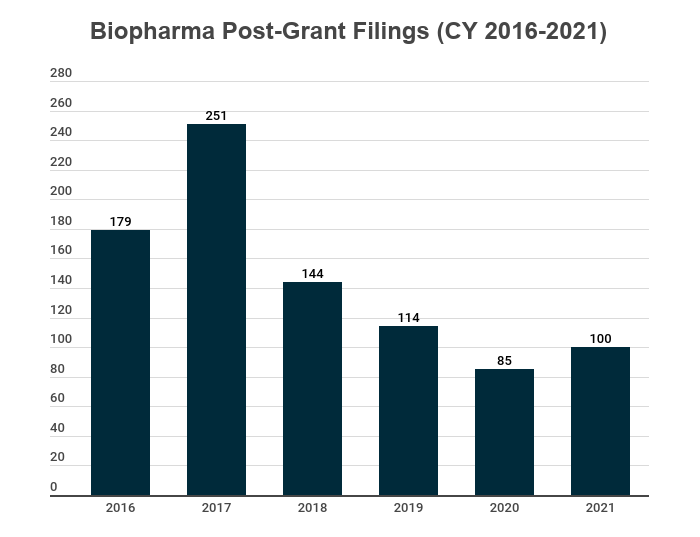Post-Grant Report
2021 Post-Grant Annual Report
Authors
-
- Name
- Person title
- Principal

-
- Name
- Person title
- Principal

-
- Name
- Person title
- Senior Principal

-
- Name
- Person title
- Principal

-
- Name
- Person title
- Principal

-
- Name
- Person title
- Principal

-
- Name
- Person title
- Principal

10 YEARS AFTER THE AMERICA INVENTS ACT (AIA), THE PATENT TRIAL AND APPEAL BOARD (PTAB) ENDURES
After a heady 2020, 2021 proved to be a return to normalcy for the PTAB. While there was significant excitement early in the year about how the Supreme Court would rule in Arthrex, its decision in June mostly maintained the status quo. With the PTAB’s constitutional defect now cured, the post-grant world refocused its attention back to more typical matters – discretionary denial, institution reviewability, and the one-year time bar, among other issues. Filings at the PTAB in 2021 also reflect a general slowdown, with a decline of about 10% from 2020.1 Nevertheless, the PTAB remains the most active forum for patent disputes nationwide, handling significantly more matters in 2021 than both the Eastern and Western Districts of Texas and the District of Delaware.2
Fish & Richardson’s 2021 Post-Grant Report takes a deep dive into the cases, trends, and statistics that shaped post-grant practice throughout the year and postulates how they may affect practitioners going forward.
When it comes to post-grant practice, Fish’s history and presence are unmatched: We have handled more cases at the PTAB than any other firm, our attorneys routinely craft new law at the Federal Circuit, and we host the most innovative educational programs. For more information, please contact practice group chairs Dorothy Whelan or Karl Renner.
For even more 2021 post-grant updates, please see our Post-Grant 2021 Year in Review webinar here.
Director Review Post-Arthrex
On June 21, 2021, the Supreme Court decided the highly anticipated Arthrex case. See United States v. Arthrex, Inc., 141 S. Ct. 1970 (2021). In Arthrex, a 5-4 majority concluded that the America Invents Act’s 35 U.S.C. § 6 grants “unreviewable authority” within the executive branch to Administrative Patent Judges (APJs) “incompatible with their status as inferior officers” under the Appointments Clause of the United States Constitution. Id. at 1976. The Court then decided in a 7-2 split to cure the constitutional violation by rendering § 6 “unenforceable as applied to the Director insofar as it prevents the Director from reviewing the decisions of the PTAB on his own,” such that “[t]he Director may engage in such review and reach his own decision.” Id. Thus, AIA trials at the PTAB were preserved, and the new age of Director review began.
On June 29, 2021 and July 1, 2021, just days after the Supreme Court decided Arthrex, the Board issued guidance on its “implementation of an interim Director review process” and conducted a “Boardside Chat” webinar regarding the same. Under the interim process, the Director may conduct a review addressing any issue of law or fact raised in a final written decision of an inter partes review (IPR) or a post-grant review (PGR). The Director’s de novo review yields no deference to the panel’s decision, a stark contrast to the rehearing procedure, which is limited to issues “the Board misapprehended or overlooked,” 37 C.F.R. § 42.71(d). But where Director review provides a more expansive evaluation of the merits, it is comparatively limited in its scope of application. Unlike rehearing, Director review is not available for non-final decisions or institution decisions.
The Director’s review of a final written decision may be initiated sua sponte or requested by a party free of charge. Similar to the procedures for rehearing, a party request for Director review is limited to 15 pages, must be filed within 30 days of the final written decision, and, if timely, resets the 63-day deadline for filing a notice of appeal. Likewise, as with rehearing, the interim procedures do not reserve briefing for the non-requesting party.
A party cannot request both Director review and panel rehearing of a final written decision, neither in parallel nor in series. But if a panel grants rehearing, a party may request review of the rehearing decision. Similarly, a new final written decision issued on remand from the Director is eligible for another round of Director review.
The pendency of Director review requests reportedly has been around two months (or more), longer than the Board’s one-month target for rehearing requests.3 As for case outcomes, early results suggest an uphill climb for requesting parties. This author’s research revealed scores of denied requests for Director review, and just two requests favorably decided on the merits. In cases where Director review was denied, the published decision took the form of a general order, bereft of substantive analysis, and resembled a Federal Circuit Rule 36 affirmance. In this way, the failed requests for Director review did not contribute to the appellate record like unsuccessful rehearing requests would have. As for the two granted cases, in each, the Director homed in on purported legal errors in the Board’s analysis and ordered the panel to issue a new final written decision under the prevailing standard. See IPR2020-00349, Paper 57 (Nov. 1, 2021) and IPR2018-00733, Paper 95 (Nov. 18, 2021). While short of a trend, these few instances of favorable review may provide helpful insight to practitioners.
Less than a year removed from Arthrex, all we can say with certainty is that it is too early to reach definitive conclusions regarding Director review. The current procedures are temporary and likely to change based on feedback from stakeholders. Moreover, a new Director is expected to assume the role in 2022 and may opt for a significantly different approach.
Discretionary Denials Update: A New Tool for Overcoming Fintiv?
In December 2020, the Board designated as precedential a decision that could provide petitioners a new avenue to avoid § 314(a) discretionary denial by stipulating that they will not pursue in district court or the International Trade Commission (ITC) any ground raised or that reasonably could have been raised in an IPR, in reference to Fintiv factor 4.
Sotera Wireless, Inc. v. Masimo Corporation
In Sotera Wireless, Inc. v. Masimo Corporation, IPR2020-01019, Paper 12 (Dec. 1, 2020), Petitioner Sotera petitioned for IPR nearly twelve months after Patent Owner Masimo filed a patent infringement suit against Sotera in the Southern District of California. In its preliminary response to the petition, Masimo argued for discretionary denial of institution under Fintiv based on the parallel district court proceeding. Sotera, on leave from the Board, filed a reply to the preliminary response highlighting a broad stipulation “not to pursue in the District Court Litigation any ground raised or that could have been reasonably raised in an IPR.” Considering the stipulation and other relevant facts, the Board weighed the Fintiv factors in favor of instituting review.
A synopsis of the Board’s analysis on each of the Fintiv factors is provided below:
Factor 1: whether a stay exists or is likely to be granted if a proceeding is instituted – Neutral
Factor 2: proximity of the court’s trial date to the Board’s projected statutory deadline – Neutral
“Here, the trial is scheduled to begin around the same time as our deadline to reach a final decision. Thus, we find that this factor does not weigh for or against denying institution in this case.” (Paper 12 at 15)
Factor 3: investment in the parallel proceeding by the court and parties – Favors Institution
Factor 4: overlap between issues raised in the petition and in the parallel proceeding – Strongly Favors Institution
Factor 5: whether the petitioner and the defendant in the parallel proceeding are the same party – Favors Denial
“Petitioner and Patent Owner acknowledge the parties are the same in the inter partes proceeding and in the parallel proceeding. . . Thus, this factor supports denying institution.” (Paper 12 at 19)
Factor 6: other circumstances and considerations that impact the Board’s exercise of discretion, including the merits – Neutral
“[O]n this preliminary record, Petitioner has met its burden of demonstrating a reasonable likelihood that it would prevail in showing that claims of the [challenged] patent are unpatentable.” (Paper 12 at 20)
Subsequent Developments
Since Sotera, other petitioners have had similar success using Fintiv-based stipulations to overcome § 314(a) discretionary denial. In Ocado Group PLC v. AutoStore Technology AS et al., IPR2021-00311, Paper 11 (June 28, 2021), Petitioner provided the following stipulation regarding its concurrent ITC investigation: “Respondents hereby stipulate that, from and after the date of this stipulation, they will not pursue a defense in this Investigation that the ’140 Patent is invalid based on grounds that were raised or reasonably could have been raised in Respondents’ IPR petition for the ’140 Patent.” Citing Sotera in its analysis of Fintiv factor 4, the Board found that the stipulation “address[ed] any concerns about overlap between the issues presented in the two fora” and instituted IPR.
Similarly, in R.J. Reynolds Vapor Company v. Philip Morris Products S.A., IPR2021-00585, Paper 10 (September 13, 2021), Petitioner R.J. Reynolds filed a “Notice of Sotera Stipulation Filing” on July 23, 2021 in its parallel district court litigation in the Eastern District of Virginia. Petitioner stipulated that it “will not pursue as to the challenged claims any ground raised or that could have been reasonably raised in that IPR in this litigation.” In its order granting institution, the Board held that “[c]onsidering that Petitioner has agreed to be bound by a stipulation with substantively the same wording as the stipulation addressed in Sotera, we are required to follow the Sotera precedent in finding that this factor weighs strongly against exercising discretion to deny institution.”
Takeaways
A broad contingent stipulation to forego invalidity grounds in district court that were “raised or could have been reasonably raised in an IPR” addresses the concerns in Fintiv of “duplicative efforts and potential conflicting decisions” (Paper 12 at 18-19). Accordingly, the Board weighs such a stipulation “strongly” in favor of institution, particularly under the Fintiv factor 4 inquiry of overlapping issues in parallel proceedings. Post-Sotera, we will likely see more petitioners relying on stipulations in an attempt to circumvent various Fintiv factors.
Developments in the Biopharma Sector
In calendar year (CY) 2021, the total number of post-grant petitions in the biopharma space, which we define as petitions involving United States Patent and Trademark Office (USPTO) Technology Center 1600 patents, was 100, which accounted for ~7% of all petitions filed. This number was more than the 85 petitions filed in CY 2020, marking the first increase in filings in five years. The majority in 2021 were IPR petitions, but 22 PGR petitions were filed. Of the cases that reached an institution decision, 75% were instituted – the same percentage that were instituted in 2020. The most active petitioners in 2021 were Sarepta Therapeutics, Inc., Spectrum Solutions LLC, JSR Corporation, and Fresenius Kabi USA LLC. The most active patent owners in 2021 were Ravgen, Inc., Regeneron Pharmaceuticals, Inc., and Nippon Shinyaku Co., Ltd.

After a slow year in 2020 for biologics4 at the PTAB, post-grant review of biologics was back on the rise in 2021. Following a year in which only three post-grant petitions were filed against patents covering biologic drugs, 2021 saw 18 biologic IPR petitions and 5 biologic PGR petitions filed. This number exceeds the 14 biologic IPR petitions filed in 2019, and rivals the 20 biologic IPR petitions filed in 2018. The most challenged patents relate to aflibercept, held by Regeneron and sold under the trade names Eylea® and Zaltrap®, and tocilizumab, held by Chugai Pharmaceutical Co. and sold under the trade name Actemra®. The patents relating to aflibercept were first challenged by Mylan Pharmaceuticals and, following institution of those IPRs in November 2021, were subsequently challenged by Apotex Inc. and Celltrion, Inc. Both Apotex and Celltrion moved for joinder with Mylan’s instituted petitions. Celltrion also filed a PGR petition against an additional Regeneron patent related to aflibercept in September 2021, which remains pending. The PTAB recently instituted two of the IPRs related to tocilizumab, and the remaining four await institution decisions.
A Slow Year for PTAB Precedential Decisions
After a relatively busy 2020 in which the PTAB designated over a dozen opinions as either precedential (11) or informative (4), the PTAB did not designate a single opinion as precedential or informative during the 2021 calendar year. However, the PTAB Precedential Opinion Panel (POP) did grant a request for POP review for only the fifth time since the panel was established in 2018. This request for POP review in Toshiba America Electronic Components, Inc. v. Monument Peak Ventures, LLC (Case No. IPR2021-00330) was the only request granted out of a total of 53 requests in 2021.
In Toshiba, the initial panel denied institution, finding the petition to be time-barred based on the USPTO not receiving the wire-transferred filing fee until Dec. 18, 2020, a day after the one-year bar date of Dec. 17.5 In denying institution, the majority determined that the petitioner’s evidence was insufficient to show that the wire transfer had been accepted by the Treasury NYC on Dec. 16 (the day the petition was filed), and that even if Dec. 16 were established as the date of the initial wire transfer, the payment was still not available to the USPTO any earlier than Dec. 18. Judge Dirba issued a rare dissent along with the denial of institution, arguing that a filing date of Dec. 16 should have been afforded based on the petitioner initiating the wire transfer prior to 3:00pm on Dec. 16 and taking no further actions with respect to the wire transfer or petition filing after Dec. 16.
After denial of institution, the petitioner filed a motion for rehearing and request for review by the POP in June 2021, arguing that the panel “abused its discretion by announcing a new USPTO rule for the payment of filing fees by wire transfer.”6 The POP subsequently granted the request for review in September on the premise that the question “Does Fedwire confirmation of payment constitute sufficient evidence of payment under 35 U.S.C. § 312(a) and 37 C.F.R. § 42.103(a)?” warranted further review and clarification.7 The parties were authorized to submit initial 15-page briefs on Oct. 22 and responsive 15-page briefs on Nov. 5. The POP did not schedule an oral hearing.
On January 14, 2022, the POP issued a decision overturning the initial panel and granting Toshiba’s request to correct the filing date to Dec. 16, 2020.8 The POP found that the USPTO permits fees to be paid by wire transfer through Fedwire and that the petitioner complied with the USPTO’s published instructions for wire transfers and completed the initiation of the wire transfer on Dec. 16, 2020. However, the POP denied institution of the petition as moot based on the Federal Circuit having affirmed a district court’s decision finding all challenged claims at issue invalid under 35 U.S.C. § 101.
Although the petitioner here was ultimately successful in establishing the earlier filing date, practitioners should heed the initial panel’s warning regarding the pitfalls of filing a petition at or near the one-year bar date to avoid the additional expense and time that such a POP review requires.
With this new decision from the POP, 2022 already has one more decision designated precedential than 2021. It remains to be seen how active the PTAB will be with respect to designating precedential decisions in 2022, whether through granting of additional POP reviews or through the more traditional method of anonymous nomination of previously issued decisions.
The Year at the Federal Circuit
A final written decision is not the end of your IPR. Rather, it is the beginning of the next stage – an appeal. To win ultimately, and to best strategize for the IPR itself, you need to understand in advance what might happen on appeal.
Institution Reviewability
Denials of institution – particularly the extent to which they are reviewable – have long been a contentious topic for the PTAB. Historical wisdom is that the Federal Circuit will not review institution decisions, whether granting or denying institution. Although that rule has not changed, the Federal Circuit touched on it in 2021 in a case that could possibly open the door to review under rare circumstances.
In Mylan Laboratories Ltd. v. Janssen Pharmaceutica, N.V., 989 F.3d 1375 (Fed. Cir. 2021), the PTAB denied institution of Mylan’s IPR petition based on the proximity of the trial date in co-pending litigation between the parties. Mylan appealed, raising both a direct appeal and a mandamus petition under the All Writs Act. The Federal Circuit held that it did not have jurisdiction to review § 314(d) institution decisions, but nonetheless held that the All Writs Act permits it to exercise mandamus jurisdiction to review those decisions.
The All Writs Act most often arises where the injured party has no other relief, and allows courts to issue all writs necessary or appropriate in aid of their jurisdiction. However, the standard of proof for mandamus is high – a petitioner must show (1) a clear, indisputable right to relief, (2) there is no other adequate method of obtaining relief, and (3) the writ is otherwise appropriate under the circumstances. The Federal Circuit held that the injury at issue here – i.e., the PTAB’s refusal to institute based on its evaluation of efficiency – falls far short of that standard because the petitioner has no clear right to relief. It further stated that it would be difficult to imagine a mandamus petition that challenges a denial of institution and identifies a clear and indisputable right to relief. Thus, while the Federal Circuit may review denials of institution under the mandamus standard, a petitioner is highly unlikely to win by going that route.
Takeaways
Discretionary denials under General Plastic and Fintiv are on the rise, and that likely will continue, given that institution decisions are practically unreviewable even in light of Mylan. For petitioners, this requires thinking carefully about the reasons for discretionary denial and how to avoid it – e.g., consider serial petitions, timing with district court litigation, and whether a Fintiv stipulation makes sense in your case. And always remember the silver lining of denied institution: no estoppel.
Estoppel
The Federal Circuit in 2021 decided two major cases concerning the implications of joinder for later estoppel against petitioners.
Network-1 Techs v. Hewlett-Packard Co., 981 F.3d 1015 (Fed. Cir. 2020) addresses estoppel from litigation into IPR. Network-1 sued multiple defendants, including HP and Avaya. Avaya petitioned for IPR, HP joined Avaya’s petition (but was not allowed to add new grounds because its joinder was more than a year after suit), and the PTAB affirmed the claims. The district court subsequently ruled on judgment as a matter of law that HP was estopped from arguing obviousness at trial. The Federal Circuit vacated, holding that HP was not estopped on grounds different than those in the IPR because, under the reasoning of Windy City Innovations, LLC v. Facebook, Inc., No. 20-1153 (Fed. Cir. 2021), HP could not have brought new grounds that were not already instituted. Thus, the court agreed with HP that none of the validity grounds at trial “reasonably could have been raised” through joinder and found that no estoppel applied.
Uniloc 2017 LLC v. Facebook, Inc., 989 F.3d 1018 (Fed. Cir. 2021) addresses estoppel applied between IPRs. Apple had previously filed an IPR petition on the challenged patent, whereafter Facebook filed two of its own petitions that were identical to Apple’s except for one additional claim. Facebook then filed a third petition identical to Apple’s and joined Apple’s petition, which had already been instituted. LG then filed petitions that copied and joined Facebook’s original pair. The PTAB issued a final written decision in the Apple IPR after all the joinders and confirmed the patentability of all the claims in that petition. On the ultimate question of how estoppel applied, the Board ruled that:
- Facebook was estopped on all claims common to the Apple petition once the Apple final written decision issued;
- Facebook was not estopped for the one extra claim it added because that was not a claim Facebook could have brought in Apple’s IPR, because Facebook joined post-institution; and
- LG was not estopped on any claims because it was not a party to Apple’s IPR and never joined it.
LG then stepped into Facebook’s shoes and pursued all of the claims Facebook was estopped from pursuing. Uniloc subsequently appealed, arguing that LG should have been estopped because it was in privity with Facebook. The Federal Circuit held that if LG were “privy to the petitioner,” it might be estopped to the same level Facebook was estopped. But because Uniloc failed to show that LG exercised any control over Facebook’s IPR’s, the Federal Circuit found that it could not show privity.
Takeaways
Network-1 and Uniloc demonstrate the estoppel-based benefits available to parties who join petitions post-institution rather than file their own petitions. For time-barred petitioners, post-institution joinder can be an especially attractive option, provided that they do not exercise control over the petitions. Petitioners should thus consider the impact of a claim-by-claim approach – can you join an instituted IPR and also challenged non-petitioned claims?
Obviousness
The Federal Circuit decided several cases touching on various aspects of obviousness in 2021.
Motivation and Objective Indicia
Motivation to combine and objective indicia are commonly disputed issues in obviousness cases. In Chemours Co. FC, LLC v. Daikin Industries, Ltd., 4 F.4th 1370, 1376 (Fed. Cir. 2021), the Federal Circuit provided guidance as to what is required for both. In that case, the patent covered a polymer used to coat communication cables. A key property of the claimed polymer is its high melt flow rate, which allows it to be coated onto wires faster. The Board found obviousness based on a single reference, which taught using a polymer with a lower melt flow rate. The Federal Circuit reversed, finding that the Board did not adequately explain why a skilled artisan would have been motivated to increase the prior art polymer’s melt flow rate, when the known ways for doing so would go against the prior art’s teachings. The Federal Circuit further found that the Board erred in disregarding the patentee’s objective evidence because it (1) incorrectly found no nexus simply because the claimed polymer was a combination of known elements, (2) improperly required market share evidence to show commercial success, and (3) misapplied the “blocking patents” doctrine to the challenged patents themselves.
The Role of Reasonable Expectation of Success
In certain obviousness cases, the question of “reasonable expectation of success” plays a role over-and-above the basic question about a motivation or reason to combine. In University of Strathclyde v. Clear-Vu Lighting, LLC, ___ F.4th ___ (Fed. Cir. 2021), the patent covered a method of photoinactivating antibiotic-resistant bacteria without a photosensitizing agent. The inventors experimented to find a wavelength range that worked well and required little energy. Reference A achieved inactivation from the claimed wavelengths but used a photosensitizing agent, while Reference B didn’t use such an agent but also didn’t achieve inactivation. The PTAB found obviousness, holding that combination taught the relevant features. The Federal Circuit reversed, holding that (a) there was no evidence for the PTAB’s finding that any bacteria were inactivated in the absence of a photosensitizing agent, and (b) others had failed here, which tends to show no reasonable expectation of success. In short, the Federal Circuit wasn’t willing to stitch the teachings together when there was a fundamental line separating them.
Enablement by Prior Art
In Raytheon Technologies Corp. v. General Electric Co., 993 F.3d 1374 (Fed. Cir. 2021), the Federal Circuit again reversed a PTAB finding of obviousness. The invention was a jet engine having a certain power-to-weight ratio. The Board found that a skilled artisan could have interpreted the prior art to determine the ratio disclosed. However, the Federal Circuit held that the Board should have asked whether a skilled artisan could build the jet engine using the technologies available at the time – not merely understand what it was. Because the prior art was not enabling, the claims would not have been obvious.
Board Shifts between § 102 and § 103
In M & K Holdings, Inc. v. Samsung Electronics Co., 985 F.3d 1376 (Fed. Cir. 2021), the petitioner had argued obviousness, but the Board’s analysis looked more like an anticipation analysis. The Federal Circuit held that this deprived the patentee of due process, in part because anticipation was not inherent in the petition’s obviousness arguments.
Motivation to Combine, Not Possible to Combine
In Adidas AG v. Nike, Inc., 963 F.3d 1355 (Fed. Cir. 2020), the PTAB found that the petitioner had not shown obviousness. The Federal Circuit, like the Board, rejected the petitioner’s argument that the teachings of the references could easily be combined, because the standard is whether there was a motivation or reason to combine. The court also found that the petitioner had not addressed certain fundamental differences between the references.
Takeaways
These decisions on obviousness highlight that IPR petitioners need to be clear and concise in their petitions regarding the types of arguments they are making and the evidence on which they rely for those arguments. Muddled arguments will lose at the PTAB and/or the Federal Circuit. With that said, greater precision and clarity require petitioners to think ahead several steps so that their petitions foresee possible counterarguments and head them off either explicitly or implicitly (and carefully). It is not enough to simply map teachings in the art to claim limitations and point to some reason to combine; rather, a petitioner should explain how and why, in a logical manner, a skilled artisan would have reached the claimed invention if the prior art were in front of them.
Post-Grant Legislative Proposals
Restoring the America Invents Act
The Restoring the America Invents Act, introduced by Senators Patrick Leahy (D-VT) and John Cornyn (R-TX), addresses a broad set of issues related to post-grant proceedings before the PTAB. Those issues include:
Director Review
The Bill codifies Arthrex by giving the Director the authority to review, modify, or set aside final decisions of the PTAB, either sua sponte or upon request by a party. The Director’s review must be issued in a separate written opinion that is made part of the public record and sets forth the reasons for the review, modification, or setting aside of the PTAB final decision. Any decision on review by the Director will be treated as a final decision of the PTAB.
Discretionary Denial
The Bill places limitations on the Board’s ability to deny institution of post-grant proceedings. Section 314(a) would be amended by striking the permissive language “The Director may not authorize an inter partes review to be instituted unless” and replacing it with the mandatory language “Subject only to the discretion of the Director under section 325(d)(4), a petition that meets the requirements of this chapter shall be instituted if.” One carve-out to the new mandatory institution standard is that the Board retains its discretion to deny institution if “the same or substantially the same prior art or arguments previously were presented to the Office.” There are no carve-outs for co-pending litigation (abrogating Fintiv) or serial petitions (abrogating General Plastic).
Concurrent USPTO Proceedings
The Bill requires parties in an ongoing proceeding to “notify the Director” if “another proceeding or matter involving the patent is before the Office, or if there is a pending application claiming the benefit of a common filing date to the patent.” And the Director “shall issue a decision” regarding how the other proceeding may advance, “including providing for stay, transfer, consolidation, or termination.” The Bill lists prosecution of continuation applications as one of the matters the Board must actively manage. This could impact the common practice of pursuing claim amendments before an examiner concurrently with ongoing post-grant proceedings. The Bill also includes “a rebuttable presumption” in favor of consolidation “if the multiple proceedings…are of like type and are filed reasonably close in time.” This provision may apply to scenarios where multiple defendants are sued concurrently and file their respective petitions around the same time. Under the current regime, if instituted, such cases typically proceed independently.
Stays
In an apparent attempt to counterbalance the elimination of Fintiv and avoid multiple proceedings involving the same patent progressing in parallel, the Bill articulates several factors that district courts must consider when evaluating stay requests based on PTAB proceedings. Courts must consider whether
- the outcome of the inter partes review will likely simplify the issues in question in the civil action and streamline the proceedings in the civil action;
- as of the date on which the stay is requested, discovery in the civil action is complete;
- a stay, or the denial thereof, would—
- unduly prejudice the nonmoving party; or
- present a clear tactical advantage for the moving party; and
- a stay, or the denial thereof, will reduce the burden of litigation on the parties to the civil action and the court.
Parties may pursue an immediate interlocutory appeal on a denied motion for a stay. The Bill states that the “United States Court of Appeals for the Federal Circuit shall review the district court’s decision to ensure consistent application of established precedent, and such review shall be de novo.”
Independence of PTAB Panels
The Bill prevents ex parte communications between any APJ and “an officer who has review authority, supervisory authority, or disciplinary authority” over that APJ “concerning any pending matter.” While this may not substantially change the current practices at the PTAB, it is at least a public confirmation of transparency and independence with respect to the decisions of PTAB panels.
Basis for Inter Partes Review
The Bill expands the grounds on which a petitioner may prove unpatentability to include admitted prior art and double patenting. It also recognizes governmental entities as permissible petitioners by clarifying that the definition of a “person” includes “a governmental entity.”
Right to Appeal
The Bill introduces a presumption of an injury-in-fact for any party that “reasonably expects that another person will assert estoppel against the party…as a result of the final written decision that is the subject of the appeal.” While the provision does not distinguish between patent owners and petitioners, the change would likely have a greater impact on petitioners. Recent decisions from the Federal Circuit have scrutinized the injury-in-fact evidence presented by petitioner-appellants not involved in co-pending district court litigation. The Bill exempts parties found to lack standing from the estoppel provisions.
Amending Claims
The Bill reverses the current state of the law as to which party bears the burden of proof regarding amended claims. At present, under the Board’s Aqua Products precedent, petitioners bear the burden of proving unpatentability. The Bill reverts the burden of proving patentability to patent owners. Additional provisions require the PTAB to “examine the substitute claim” and the Director to “cause an examination of the substitute claim to be made within the time limits for the applicable inter partes review.” It remains unclear whether the reference to “examination” will lead to more conventional examination, e.g., with input from the Central Reexamination Unit or the examining corps.
Estoppel
The Bill adjusts the timing of estoppel against petitioners by stating that it does not attach until the right of appeal has been exhausted or a decision on appeal has issued. The current state of the law is that estoppel attaches to the petitioner when a final written decision is issued. It further clarifies that parties joined to a proceeding (in addition to their real parties-in-interest and privies) are subject to the same estoppel as the original petitioner. The Bill also codifies the patent owner estoppel provisions found presently only in the Office regulations. In doing so, it precludes the Office from issuing “any claim that is not patentably distinct” from a claim found unpatentable or canceled during review. Whether the term “canceled” applies to amendments, disclaimer, or both is not immediately clear.
Exceptions to the One-Year Time Bar
The current articulation of 35 USC § 315(b) bars petitions “filed more than 1 year after the date on which the petitioner, real party in interest, or privy of the petitioner is served with a complaint alleging infringement of the patent.” In addition to retaining the original exception of requests for joinder, the Bill introduces two new exceptions. First, in answer to the Supreme Court’s Thryv v. Click-to-Call Technologies decision, the Bill states that the time bar “shall not apply…if the complaint is dismissed without prejudice.” Second, the Bill adds that any “new or amended claims [that] issue from reexamination” can be challenged no later than one year after the date on which such claims are asserted in the action that triggered the time bar on the original claims. This new exception addresses a peculiarity of reexaminations by which amendments are not treated as part of a new patent – as with reissue – but instead part of the original patent.
Restoring America’s Leadership in Innovation Act
The Restoring America’s Leadership in Innovation Act, introduced by Rep. Thomas Massie (R-KY-4), would repeal large portions of the AIA and abrogate several Supreme Court decisions, including Alice and eBay vs. MercExchange. In addition to returning the United States to the “first-to-invent” system, ending the automatic publication of patent applications, and reestablishing best mode as a condition of patentability, the Bill would abolish most post-grant proceedings and the PTAB itself.
The Bill contains several post-grant-related provisions, including:
Abolishing Inter Partes and Post-Grant Review
The Bill would repeal Chapters 31 and 32 of title 35 of the United States Code, thereby abolishing IPR, PGR, and inter partes reexamination. The repeal would be based on the following findings:
- [I]nter partes review and post-grant review proceedings introduced by the Leahy-Smith America Invents Act have harmed the progress of science and the useful arts by subjecting inventors to serial challenges to patents;
- inter partes review and post-grant review proceedings invalidate patents at an unreasonably high rate; [and]
- patent rights should be protected from unfair adjudication at the Patent and Trademark Office and duly issued patents should be adjudicated in a judicial proceeding[.]
Ex parte reexamination proceedings under Chapter 30 would be preserved.
Abolishing the Patent Trial and Appeal Board
The Bill would also abolish the PTAB (which would no longer be needed after the abolition of IPR and PGR), and reestablish the Board of Patent Appeals and Interferences (BPAI). The BPAI would be composed of the Director, the Deputy Director, the Commissioner for Patents, the Commissioner for Trademarks, and APJs. The APJs would be appointed by the Secretary of Commerce in consultation with the Director.
The duties of the BPAI would include reviewing adverse decisions of patent examiners and determining priority and patentability of inventions in interferences under § 135(a). Each appeal or interference would be heard by at least three members of the Board, who would be designated by the Director. The Board would be barred from invalidating issued patents except in ex parte reexamination proceedings.
A party dissatisfied with a decision of the BPAI in examinations and reexaminations may appeal the decision directly to the Court of Appeals for the Federal Circuit or may seek review de novo in any district court of the United States. A party dissatisfied with the decision of the BPAI in an interference may appeal the decision to the Court of Appeals for the Federal Circuit.
Presumption of Validity and Tolling of Patent Term
The Bill would establish a presumption of validity of patents challenged in both judicial and administrative proceedings, and would further toll the term of the challenged patent from the time the patent is challenged to the time of resolution of the validity issue by the court.
- Source: Lex Machina. 1,538 filings (2020) vs. 1,386 filings (2021)
- Source: Lex Machina as of 1/5/2022.
- Some studies have suggested that the pendency of rehearing requests is closer to two months.
- We define “biologics” as antibodies, small peptides (<40aa) and the like used in humans. We exclude animal vaccines and animal therapeutics.
- Toshiba America Electronic Components, Inc. v. Monument Peak Ventures, LLC, IPR2021-00330, Paper 9
- Id., Paper 10
- Id., Paper 13
- Id., Paper 20
The opinions expressed are those of the authors on the date noted above and do not necessarily reflect the views of Fish & Richardson P.C., any other of its lawyers, its clients, or any of its or their respective affiliates. This post is for general information purposes only and is not intended to be and should not be taken as legal advice. No attorney-client relationship is formed.